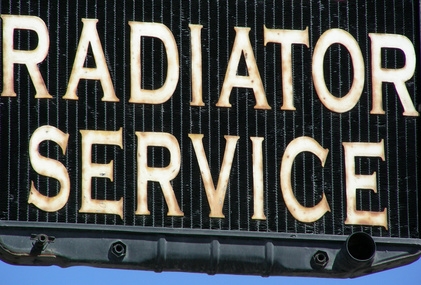
An overheated, overflowing radiator can be very harmful to your car, truck or van. Unfortunately, overheating does not usually happen at a convenient time or place. Overheating occurs when the temperature of your coolant becomes hotter than the normal operating temperature range of your engine. Typically, summer is the most common time for your radiator to overheat. This is because idling in hot weather for long periods of time does not allow your water pump to turn fast enough, which can prevent coolant from circulating as it should.
Pull over to a safe area if your radiator begins to overheat. Continuing to try to drive with an overheating radiator can cause irreversible damage to your car's engine. Don't turn off the engine yet.
Check the engine temperature gauge, which is located on your dashboard--usually on the opposite side from your gas gauge. It likely reads "hot."
If it does not, this could point to larger problems, like a broken thermostat. If this is the case, you will want to call a towing service after trying out a few simple tests.
Turn off your air conditioner if your temperature gauge reading is "hot." Watch to see if the temperature level drops at all; if it does, turn your vehicle's heater to full blast. This might not be comfortable in the heat of summer, but it could keep your engine's head from cracking. This will cool the engine by transferring the heat through the air.
Pop the hood, then check the coolant tank. Coolant reservoir tanks are generally located on the left-hand side of the engine. They resemble your windshield washer tank, but with a notable difference: a hose on the tank runs to your radiator. If the coolant tank is low, then add equal parts of coolant and water to the coolant tank. This should alleviate the problem.
Next, check your radiator. Turn off your vehicle and allow the engine to cool before removing your radiator cap. If the radiator is low or empty, again, add equal parts water and coolant to it. This will likely resolve your problem.
Inspect the tubing that runs from the coolant tank to the radiator, especially if both your radiator and coolant tank appear to be full. Sometimes an air bubble can form in this tube that will prevent the back-and-forth flow of coolant. Check the ends of the tube, too, to make sure they are attached firmly. A loose connection can cause your cooling system to malfunction. If the ends appear to be firmly in place, gently squeeze the tube along its length to work any possible air bubbles out. Also check the larger hose that attaches to the radiator. If it appears to be loose, tighten with a screwdriver.
Call a towing service if none of the above troubleshooting methods and fixes work. Continuing to drive your vehicle while it is overheating can damage the vehicle and endangers your safety.